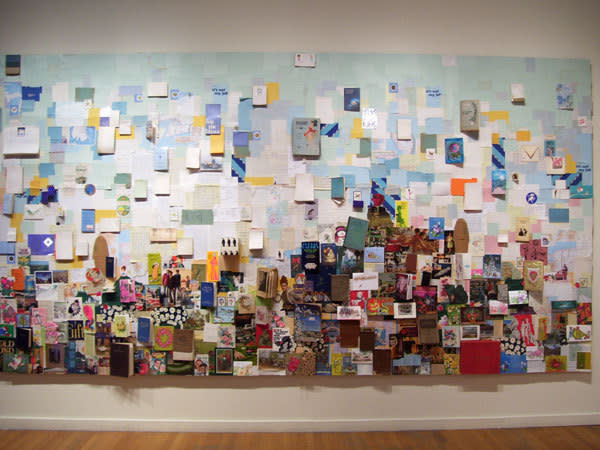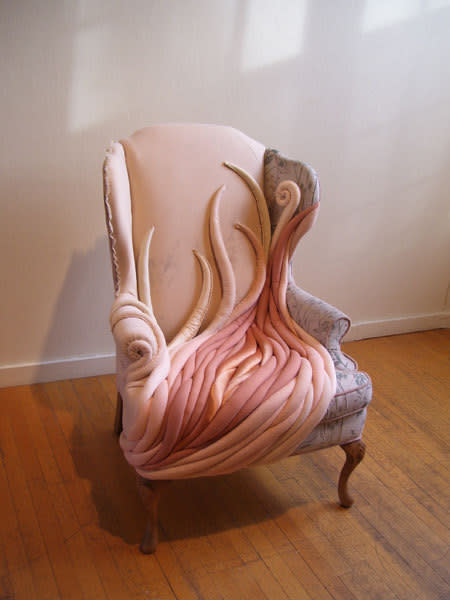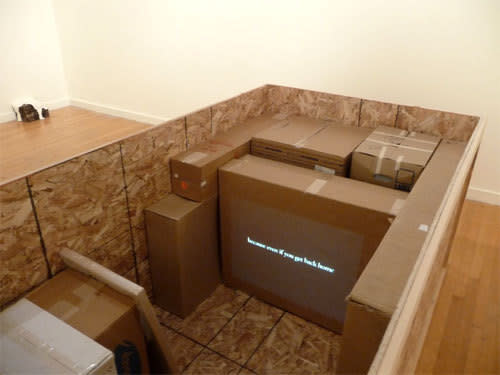Review: Dregs and Imaginative Qualities
Portlanders who frequent visual arts events likely know Paul Middendorf, director of Gallery HOMELAND, as a tireless curator, artist, and administrator who has been bringing the work of Portland artists to the public eye for a number of years now—first at the Modern Zoo and Disjecta, and more recently through HOMELAND’S Scratching the Surface festival. It is wonderful that he has an exhibition at our region’s premier independent art venue just as his most ambitious project, East West Berlin, is taking off. East West Berlin is a collaboration with NY gallery Dam Stuhltrager, exhibiting artists from Portland and New York in Berlin.
For “The Dregs” at the Art Gym at Marylhurst University, Middendorf does as an artist what he does best as a curator/administrator, he collaborates…here with Brandy Cochrane. Made from the items that were left behind after an estate sale, “The Dregs,” we are told, is meant to “honor the story” of the family to which the objects belonged. Specifically, the story concerns the family’s grown son who continued to live in the family home with his mother when his father died, and alone after she too passed away.

from The Dregs, Paul Middendorf and Brandy Cochrane. 2009
Some material is presented as-is in consciously selected groups. There are two large wall collages—one laying bare a number of facts about the family from their papers and another made up of the colorful paper ephemera one tends to accumulate: greeting cards, ledgers, and notebooks—a double-sided display of a multitude of travel-sized soaps and assorted brushes (“Clean/Dirty”), and a small back room painted a yellow that I suspect was sourced from the home in question, filled with odd items displayed as if in a particularly good thrift store.
The rest of the works are crafted of found object as in the lively assortment of oversized papier-mache spheres like the cleverly-titled, satin-beribboned globe called “Don’t Take Larry” which sounds ominous or odd until one finds, in a Welch Ade box in the yellow room, a cardboard spool of satin ribbon on which Elsie has written in pen, “Don’t Take Larry” by which she meant, I’m sure, “Don’t take, Larry.” (Commas matter!) Falling as well into this category are the bedsprings embellished with the word “Crestfallen” in purple neon letters.
It would take an extraordinarily sensitive touch to allow the deceased to speak for themselves through their things. Where “Dregs” trips is when the artists speak on their behalf. One worries that whereas the artists mean “The Dregs” to be a work of narrative anthropology, it ends up feeling closer to the voyeuristic fiction of a “reality” television show, editing the lives of real people—their names, addresses, places of employment are revealed—into the authors’ version of reality. Their neighbors and relatives may see this show, one can’t help thinking.

Beloved Mother. Paul Middendorf and Brandy Cochrane. 2009
One of the most beautiful pieces in the show is an arm chair upholstered with a tangle of octopus-like tentacles in shades of pastel pink and peach reaching up from the bottom of the chair, roiling across the seat, and curling up the back. “Beloved Mother” is crafted of the mother’s undergarments, the grasping mother holding on to her “Beloved Son” (the title of a trio of found portraits nearby of a beautiful young man) or comment on the grown man who can’t leave mother. Does it “honor” the family to draw this conclusion? Even trickier is the piece across the room, the embroidered drawings of two sleeping men on a stained Beautyrest mattress. They create three collages of the silhouette of a man with an erection (one cut from a male beefcake photo), and include in the yellow room a cardboard box of gay-porn videotapes. Airing a family’s dirty laundry in more ways than one—we have to consider the possibility that a man of the son’s generation (he was in his 70s when he died) might well not have been out to all who knew him—the artists veer toward exploitative, tabloid territory.
Remind me, if you know me, as I teeter at death’s threshold, to set the bloody house on fire.

Imaginative Qualities of Actual Things. Anna Gray and Ryan Wilson Paulsen. 2009. Marylhurst Art Gym.
Which brings me to the installation in the Art Gym’s second gallery, “The Imaginative Qualities of Actual Things” by Anna Gray and Ryan Wilson Paulsen. This too is a narrative told through objects, and it is intensely personal. The few charred objects (the neck of a guitar, a computer, a stack of notebooks) that are embedded in or hugging the walls of the space were salvaged after their home burned. These objects have previously appeared in the duo’s book project about the fire, Integrating a Burning House.
The center of “The Imaginative Qualities of Actual Things” is a video poem nestled in a box of boxes (a massive chipboard crate half full of cardboard storage boxes), an apt representation of the limbo in which the artists live as their home is rebuilt. Their poem richly addresses the dawning of the realization that the path taken to be circular (going home again) is in fact a curve approaching, but never reaching its asymptote. “A lot is different,” the artists say in the introduction to their book.
I puzzled over the relationship of the charred objects to the walls. Why does the plaster and paint seem to melt over a stack of newsprint, while the postcard and paintbrush appear to have been blown outward from the center embedding themselves cleanly like shrapnel? Why does the computer sit at a remove? And yet the whole, bound around the poem, is poignant and real.
It’s a subtle art to mine autobiography while avoiding the maudlin. In less capable hands their work around the burning house would fall to pieces like a bad teenage diary entry. Something about the way Gray and Paulsen treat the material, in a manner that is matter of fact yet deeply considered, makes it work.
